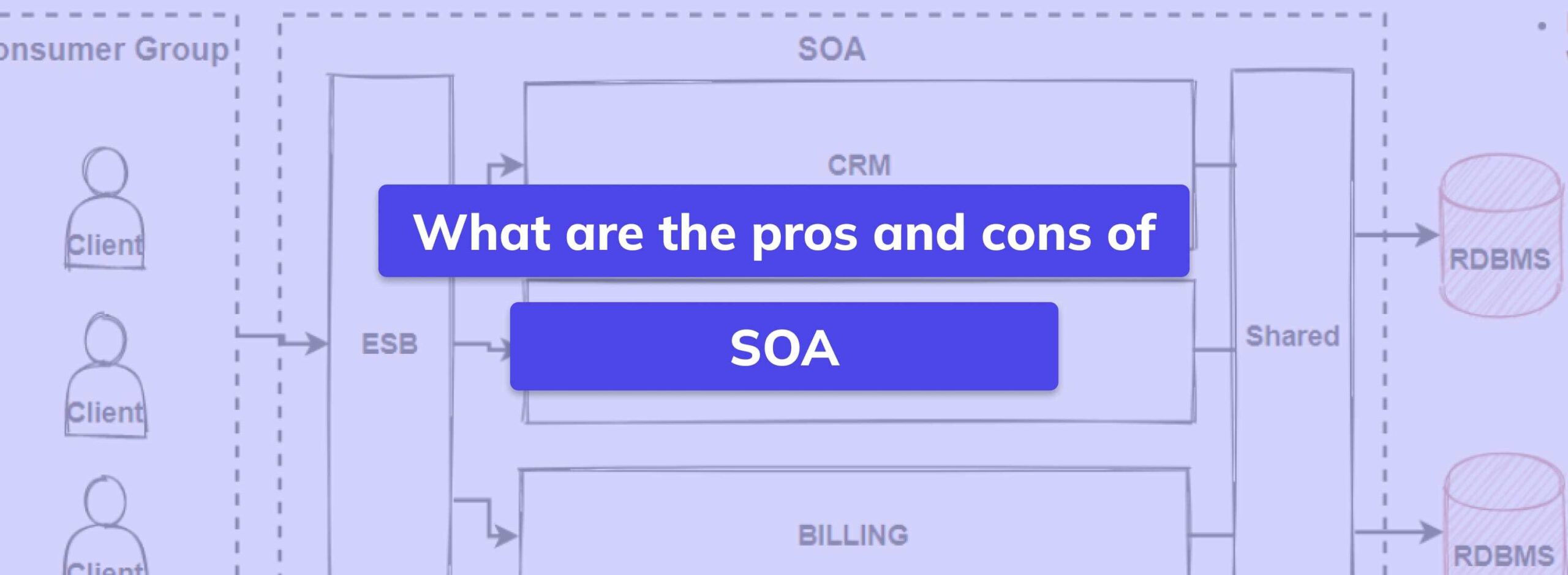Service-oriented Architecture (SOA) is one of the tremendous technological advancements in the tech industry since monolithic architectures became trendy. SOA is a blooming system architecture with a projected global revenue of over ninety million euros as of 2020.
For many years, creating software required using modular functional parts to be placed in various locations within an application to complete a single task. Developers then sought to modify their procedure-based development model to use remotely distributed components in application integration and component-sharing activities, which will be connected to a collection of hosting resources and disseminated databases.
This birthed the concept of Service-oriented Architecture (SOA), which has then gone on to become an integral part of visualisation and modern cloud computing. This article will discuss the pros and cons of implementing a service-oriented architecture. We also got you covered if you want to know various service-oriented architecture benefits.
What is Service-oriented Architecture (SOA)?
Service-oriented architecture (SOA) is an architectural scheme that tries to create modular applications of independent services or components, each performing a particular function and interacting in coordination. These components are suitable for enterprise-level businesses because they are reusable and may be utilised in creating standalone applications.
It is a form of architecture based on services with a clearly-defined and independent capability. In this design, many services interact with one another to carry out specific tasks. These services are loosely connected, so one service can be made aware of the specific techniques of another service it is dealing with. A service consumer and a service provider are the essential components of SOA. The consumer makes a service request, and the service provider provides the requested service and returns the response.
What Does SOA Stand For, and How Does It Work?
Service-Oriented architecture stands for a method of making reusable and interoperable software components. The components are built and arranged into common architectural patterns to be incorporated into multiple applications. The principle is also centred on the structuring of a system’s components based on the services they offer.
A system’s components are arranged in a service-oriented architecture (SOA) with respect to the services they offer. The architecture’s coupling interaction between the service provider and the requester enables the services to function regardless of the platform on which they will be utilised.
SOA systems are well-defined, fully functional, and independent. They are neither affected by the environment in which they are implemented nor by other linked components. This makes their functioning completely independent.
Service-oriented Architecture Benefits
The benefits of Service-oriented architecture stem from its ability to translate technologies into fundamental business service, which is unquestionably a crucial aspect for businesses looking to succeed in an increasingly competitive market. SOA benefits businesses in the following ways:
- Its utilisation can help technology and business sectors align and get closer together.
- Since SOA offers a shared infrastructure, documentation, and the option to construct services, it enables the development of more manageable and safe applications.
- SOA provides security and high availability, which helps companies to reduce data loss to a minimum.
- Due to the flexible integration of all data, SOA architecture enables a quicker and more cost-effective application development process.
- Organisations can also increase their system flexibility and agility thanks to SOA.
Pros and Cons of Service-Oriented Architecture (SOA)
Here are the advantages and disadvantages of Service-oriented Architecture Applications:
Pros of Service-Oriented Architecture (SOA)
- Reusability of services
SOA-based applications are created by assembling small, independent, and loosely linked functional components. Consequently, the services can be used in many applications without concern for how they interact with other services.
- Simple maintenance
An SOA can be readily upgraded or maintained without worrying about other services because it is independent. Thus, it is easy to manage large, sophisticated applications.
- Increased dependability
Applications built with SOA are more dependable because small, independent services are simpler to test and debug than large blocks of code.
- Location independence
Typically, the services are included in a directory so that customers may search for them. This strategy enables a service to relocate at any time. However, with a directory lookup, customers may always find the service they need.
- Enhancements to Scalability and Availability
On several servers, a single SOA may work in multiple instances simultaneously. This makes the service more scalable and readily available.
- Improving software quality
Services can be reused; hence duplicating functionality is minimised. As a result, the quality of the code is increased, and errors caused by inconsistent data are reduced.
- Multiple platform enablement
By combining various goods from many vendors, irrespective of the platform and technology, SOA makes it easier to design complicated products.
- Locational independence
Typically, the services are included in a directory so that customers may search for them up. This strategy enables a service to relocate at any time. However, with a directory lookup, customers may always find the service they need.
- Enhancing Productivity
Developers can add new functionality and reuse existing legacy apps without starting from scratch. In addition to raising developer productivity, this significantly lowers the cost of creating an application.
Cons of Service-oriented Architecture (SOA)
- Longer timing
Complete input parameter validation occurs each time a service communicates with another service. As a result, the overall performance decreases, and the response time and machine load increase.
- Complex Services
The provider needs to ensure that messages are delivered on schedule. However, when services continue exchanging messages to carry out duties, even a single application’s message volume can reach millions. The management of such a large amount of services presents a significant difficulty.
- High cost
Implementation of SOA requires a significant investment in technology, development and human resources.
Applications of Service-Oriented Architecture
Before usage, SOA architecture is first implemented using different web services. What service to utilise will depend on the system’s intended outcome.
Most common web services used include simple object access protocol (SOAP) and web services description language (WSDL).
Applications of SOA include:
- Numerous militaries and the air force implement situational awareness systems using SOA.
- Healthcare companies use SOA to enhance healthcare delivery.
- Mobile apps and games can leverage built-in features like GPS because of SOA.
- Museums employ SOA to build virtualized content and information storage systems.
- e-commerce websites applies SOA through the integration of a payment service like PayPal
- e-commerce websites applies SOA by using TCS service (or any other provider) for actual product delivery
Conclusion
SOA is a flexible idea for creating various injectable services. It offers a lot of advantages, such as scalability, availability, and reusability among others. The foundational idea behind SOA is the creation of independent scalable services capable of working on multiple platforms. It can be applied in a long term perspective in different industries. However, it takes a lot of experience before it can be applied most effectively.







